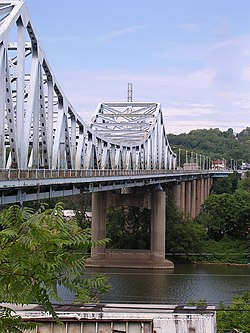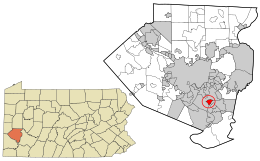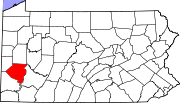Dravosburg, Pennsylvania
Dravosburg | |
|---|---|
Borough | |
 | |
 Location in Allegheny County and the U.S. state of Pennsylvania. | |
| Coordinates: 40°21′1″N 79°53′22″W / 40.35028°N 79.88944°W | |
| Country | United States |
| State | Pennsylvania |
| County | Allegheny |
| Area | |
| • Total | 1.06 sq mi (2.75 km2) |
| • Land | 0.97 sq mi (2.51 km2) |
| • Water | 0.10 sq mi (0.25 km2) |
| Population (2010) | |
| • Total | 1,792 |
| • Estimate (2017)[2] | 1,745 |
| • Density | 1,802.69/sq mi (695.89/km2) |
| Time zone | UTC-5 (Eastern (EST)) |
| • Summer (DST) | UTC-4 (EDT) |
| FIPS code | 42-19856 |
Dravosburg /draːˈvoze:burg/ is a borough in Allegheny County, Pennsylvania, United States, and is part of the Pittsburgh Metro Area. The population was 1,792 at the 2010 census.[3] Dravosburg is located along the Monongahela River.
History
The records of Dravosburg date back to 1769. The first settler was John Gray also known as George Gray. Prior to that time, an early deed was recorded of this section as far as Hays, known then as Six Mile Ferry. This section was granted to John Gray by John and Thomas Penn, sons of William Penn, the founder of Pennsylvania. The original deed is in the hands of the C. L. Whitaker family of Dravosburg.
The property, formerly known as Mt. Gray, 18 remembered as the Cunningham farm, a heritage of the Gray family. The first home of the Cunningham family was a two room log house overlooking the River, built in 1851& and known as Amity Settlement arid later was the home of Conrad Goldstrom. The second home of the Cunningham family is now Airways Tavern at the junction of the Lebanon Church Road and the Pittsburgh-McKeesport Boulevard. The Jabez Grooms Family lived in this house and farm for many years. The civil War halted further building on the hill as many of the young men were in the service.
In 1789, the land where Richland Cemetery is located was deeded to Conrad Latterbock. The land extended back as far as the property now known as Curry Hollow. The cemetery section was used as a private burial place and was known by two names - Richland and Coventry. In 1837 this land was deeded to the Curry family and known as the Curry Place. Part of this land is still known as Curry Hollow. The Curry home was a log house located near the Junction of the Elizabeth Road and Washington Avenue.
Dravosburg, a part of Mifflin Township, was incorporated into a March 31, 1903. The first Burgess was Stephen Crump elected May 6, 1903. The first councilmen who held the first meeting in the Risher Real Estate Office, located at the site of the Richards Building, were V. C. McCune, J. D. Myers, E. E. Chester, Charles Corey, C. L Stoops, John Ord and Harvey Berger. Mr. McCune was elected President of Council. Mr. Berger was ill when the first meeting was held and died two days later. This meeting was held May 11, 1903.
The first order of business after organization was to hire a policeman, who also served as street commissioner, buy a revolver, a mace, two pairs of handcuffs and order a lockup built. It was ready June 7, l904. This building located across the tracks from the P.R.R. Station still stands but has net been used as a Jail for a few years.
Since the first mine was opened in 1835, a great change has taken place. From a small group of homes centered around the mine, the town grew into a flourishing residential community. If, in 1903, Dravosburg was a quiet, peaceful community, why the revolver, mace, handcuffs and a lockup built?
Dravosburg started with the opening of a coal mine at the extreme north end of town by William and John Cunningham in 1835 and continued to operate until 1856 when it was sold to Mr. William Stone. Mr. Stone operated the mine until his death. It was then taken over by his heirs and operated until it was worked out. The area was known as Stonesburg.
On March 22, 1856, Mr. Whigham hauled coal across the river to McKeesport. The ice was four feet thick. In 1840 the Dravo mine was opened by James O'Neil. Mr. O'Neil operated the mine until 1851. It was then sold to Michael Dravo and sons. Six beehive coke ovens were built. The slack from the mine was used in the manufacture of coke. The coke was shipped by river to southern markets.
In 1809, the mine and coke ovens were sold to J. C. Risher by John P. Dravo. A third mine known as the Amity mine was opened in 1851 by J. C. Risher. Mr. Risher leased the mine to Daniel Bushmiller who operated it until 1859. It vas then taken back by the Rishers. Mr. Risher operated the mine until his death in 1889. The mine was then taken over by S. S. Crump and was then known as the Risher mine. It continued to operate until 1900, when it was sold to the Pittsburgh Coal Company. They shipped coal by rail and river until the mine was worked out.
As early as 1865, there were two saw mills in Dravosburg. One was owned and operated by William McCleary who sold the mill in 1880 to Alva Gulp. Mr. McCleary stayed on and under his supervision, the mill did a thriving business. Mr. Culp owned the mill only two years when his hand was amputated by a saw he was operating. Mr. Culp also owned a boat yard, but lost all interest in the work and the mill was abandoned. The machinery was sold, but the buildings stood until they were destroyed in the 1936 flood. The mill was located about 300 yards south of the Stone's Coal Tipple.
The Risher mill was in the upper part of town and was a boat yard and dock. In 1900 W. C. McCune purchased the holdings and operated it until his death in 1918. It was then bought by the Hillman Coal Company and was used as a landing and boat yard until April, 1951, when they moved to Elicia, Pennsylvania. The Ohio Barge Line is now using the river front as a landing.
When Dravosburg incorporated as a Borough, a school board was needed. On May 6, 1903, five directors were elected. They were Dr. A. H. Aber, Dr. F. F. Sumney, Charles Downey, John Kerr, G. L. Applegate and Sam Morrison. There was a tie between Applegate and Morrison - Applegate was chosen. The first school in Dravosburg was under the jurisdiction of Mifflin Twp. located on the river road later known as the Amity Hotel. In 1850 a small one room school was built at the foot of the hill on McClure Street. William Hull taught here as long as the building remained. In 1855 a two room school was built beside the one room building. Robert L. Riggs taught the upstairs room and Miss Lissie Corey, who later became Mrs. William Whitaker, taught the downstairs room. A small one room school stood at the mouth of Martins Hollow near the site of the German Lutheran Church that was moved when the P.V.C. RR came through in 1873. In 1891, a frame school was built on the hill at the present site of the Third Street Building but was destroyed by fire in 1905. Classes were held in the Richard's building and the German Lutheran Church until the brick building was built on Third Street. It was completed in 1907. In 1896 the Amity Academy was established as a private school with the McClain Brothers teaching. It was located on Washington Avenue near Second Street. During. World War II, the McCave School was built on the Weiskircher farm on the North Hill. It was named in honor of W. L. McCave who served many years on the school board.
Prior to 1885 only private boats were available in Dravosburg. In 1862 packets were put in service. The first boat trip to Pittsburgh was called the Reece. The Reece also made trips to Elizabeth. It carried freight mail and passengers. The fare to Pittsburgh was $1.00 one was. The ferry boats Tillie, Jac Gumbert and H. B. Sinclair were used to ferry people to McKeesport. When the Dravosburg Bridge over the Monongahela and the Third Street Bridge over the Youghiogheny were built, the ferry boats were taken out of service.
The first attempt at Christian work in this locality was the organization of a Union Sunday School in the early 1850's. In 1860, S. S. Crump took charge and continued the work for two years. In 1866, Levi Risher reorganized the school which became the corner stone of the present Presbyterian Church. Mr. Risher left in 1869. The Pastors of the First Presbyterian Church in McKeesport and of the Lebanon Church carried on the work. In 1870, Mrs. J. C. Risher built the first Presbyterian Church located on Washington Avenue. It was dedicated March 26, 1871 and was deeded to the Pittsburgh Presbytery on August 4, 1886. On April 1, 1891, it was deeded to the congregation known as Amity Presbyterian. Rev. Schriver of Lebanon Church conducted services. In 1874, the congregation effected a church body with 29 charter members. In May, 1877, Rev. Levi Risher was installed as a regular pastor. The church now had 110 members and 140 in the Sunday School. Rev. Risher continued as pastor for four years. Rev. Cyrus B. Hatch was the next minister, serving from 1885 to 1891. Rev. John Waddel served from 1892 to 1896. Rev. W. S. McKee served from 1896 to 1905. In 1902, work was started on the parsonage located at the corner of Mound Avenue and Raymond St. Rev. N. N. Rodgers served from 1905 to 1910. Rev. T. R. Turner served from 1910 to 1917. During Rev. Tuner's term, lots where the Church now stands, were purchased. Rev. T. R. Lewis served from 1917 to 1921. Rev. J. M. Cox, while still a student, came January 22, 1922 and was installed June 21, 1922. Work started on the new Church August, l924. The Sunday School room was the only one planned at this time. Rev. Cox left in 1928. Rev. John S. Vance served from 1828 to 1929.
On October 6, 1901, the Sunday School of the First Christian Church met and organized in the public school building. The Rev. J. A. Joyce of McKeesport presided. A new church was built on a site donated by S. S. Crump at the comer of Duquesne Ave. and Raymond St. The building was completed in 1902. The first service was January 18, 1902.
When the Pittsburgh Virginia and Charleston R.R. came through town in 1873, an old Lutheran Church stood at the mouth of Martins Hollow. The railroad had to go into court for permission to purchase the land because it was gift from John F. Dravo When the property was sold another site had to be bought. The Site of the St. John's s Lutheran Church was chosen. The congregation also owned a burial ground on the North Hill on Duquesne Ave.
The Methodist Church was organized October 31, 1889. Rev. Marshall B. Lytle held services in the German Lutheran Church building now known as St. John's Lutheran Church on Fifth Street until early summer of 1900. In the meantime, a Tabernacle was built at the corner of Third Street and Euclid Ave., later the home of James Cothery, Sr. The Methodist Church was built across the street and completed June 22, 1902 and was dedicated by Bishop J. W. Hamilton of' Pittsburgh.
J. C. Risher laid out the plan of Amity about 1851. The leaders of the community campaigned for a Post Office. They wanted Amity to be the name of the new Post Office but was rejected because there was a town by that name in Washington County. The name Dravosburg was chosen in honor of John F. Dravo. The population in 1875 was 1900. John F. Dravo was the first Postmaster. Those that followed were W H. Crump, Peter Ables, T. D. Watkins, Dr. F. F. Sumney, E. McBride, H. Seilers, John Brown, F. Downey, E. H. S. E. Rogerson, F. A. Meehn and J. N. Nicols. Robert J. Creely
The Dravosburg bridge was built 1889 - 1890 at a cost of $110,000.00. The Mansfield Bridge cost $8,.000,000.00. Street cars came to Dravosburg in 1890 but the tracks ended on McClure Street at the PVC RR Crossing. Patrons got off the cars and walked a long flight of stairs and boarded a car for Pittsburgh. The viaduct was built in 1897.[4]
Geography
Dravosburg is located at 40°21′1″N 79°53′22″W / 40.35028°N 79.88944°W (40.350219, -79.889391).[5]
According to the United States Census Bureau, the borough has a total area of 1.1 square miles (2.8 km2), of which 1.0 square mile (2.6 km2) is land and 0.1 square miles (0.26 km2), or 9.73%, is water.
Dravosburg is bounded on the north, west and south by West Mifflin. To the east is the Monongahela River and the city of McKeesport. The cities of Duquesne and Clairton are also nearby.
Surrounding and adjacent neighborhoods
By land, Dravosburg is entirely surrounded by West Mifflin. Across the Monongahela River to the east, Dravosburg runs adjacent with McKeesport and Glassport, both boroughs sharing a direct connector via Mansfield Bridge.
Government and Politics
| Year | Republican | Democratic | Third Parties |
|---|---|---|---|
| 2016 | 56% 467 | 41% 342 | 3% 23 |
| 2012 | 45% 365 | 54% 439 | 1% 14 |
Emergency services
Law enforcement and emergency medical services are contracted to the McKeesport Police Department and McKeesport Ambulance Rescue Service respectively.[8] Dravosburg is served by its own volunteer fire department.[9]
Demographics
| Census | Pop. | Note | %± |
|---|---|---|---|
| 1880 | 850 | — | |
| 1910 | 1,895 | — | |
| 1920 | 2,204 | 16.3% | |
| 1930 | 2,391 | 8.5% | |
| 1940 | 2,277 | −4.8% | |
| 1950 | 3,786 | 66.3% | |
| 1960 | 3,458 | −8.7% | |
| 1970 | 2,916 | −15.7% | |
| 1980 | 2,511 | −13.9% | |
| 1990 | 2,377 | −5.3% | |
| 2000 | 2,015 | −15.2% | |
| 2010 | 1,792 | −11.1% | |
| 2017 (est.) | 1,745 | [2] | −2.6% |
| Sources:[10][11][12][13][14] | |||
As of the census[13] of 2000, there were 2,015 people, 948 households, and 563 families residing in the borough. The population density was 1,981.8 people per square mile (762.7/km²). There were 1,021 housing units at an average density of 1,004.2 per square mile (386.5/km²). The racial makeup of the borough was 98.71% White, 0.50% African American, 0.25% Native American, 0.25% from other races, and 0.30% from two or more races. Hispanic or Latino of any race were 0.60% of the population.
There were 948 households, out of which 22.6% had children under the age of 18 living with them, 47.0% were married couples living together, 9.6% had a female householder with no husband present, and 40.6% were non-families. 36.8% of all households were made up of individuals, and 18.6% had someone living alone who was 65 years of age or older. The average household size was 2.13 and the average family size was 2.77.
In the borough the population was spread out, with 18.5% under the age of 18, 7.2% from 18 to 24, 28.0% from 25 to 44, 26.6% from 45 to 64, and 19.7% who were 65 years of age or older. The median age was 42 years. For every 100 females, there were 84.0 males. For every 100 females age 18 and over, there were 83.3 males.
The median income for a household in the borough was $30,461, and the median income for a family was $39,663. Males had a median income of $30,435 versus $22,232 for females. The per capita income for the borough was $17,264. About 7.5% of families and 12.6% of the population were below the poverty line, including 17.7% of those under age 18 and 8.4% of those age 65 or over.
References
- ^ "2017 U.S. Gazetteer Files". United States Census Bureau. Retrieved Mar 24, 2019.
- ^ a b "Population and Housing Unit Estimates". Retrieved March 24, 2018.
- ^ "Race, Hispanic or Latino, Age, and Housing Occupancy: 2010 Census Redistricting Data (Public Law 94-171) Summary File (QT-PL), Dravosburg borough, Pennsylvania". U.S. Census Bureau, American FactFinder 2. Archived from the original on September 11, 2013. Retrieved September 19, 2011.
{{cite web}}: Unknown parameter|deadurl=ignored (|url-status=suggested) (help) - ^ "history of Dravosburg, Pennsylvania". www.usacitiesonline.com. Retrieved 2019-03-20.
- ^ "US Gazetteer files: 2010, 2000, and 1990". United States Census Bureau. 2011-02-12. Retrieved 2011-04-23.
- ^ EL. "2012 Allegheny County election". Pittsburgh Tribune-Review. Retrieved 15 October 2017.
- ^ EL. "2016 Pennsylvani general election..." Pittsburgh Post-Gazette. Retrieved 15 October 2017.
- ^ "New pact continues McKeesport police patrols in Dravosburg | TribLIVE". triblive.com. Retrieved 2019-02-16.
- ^ "Borough of Dravosburg". Borough of Dravosburg. Retrieved 2019-02-16.
- ^ "Number and Distribution of Inhabitants:Pennsylvania-Tennessee" (PDF). Fifteenth Census. U.S. Census Bureau.
- ^ "Number of Inhabitants: Pennsylvania" (PDF). 18th Census of the United States. U.S. Census Bureau. Retrieved 22 November 2013.
- ^ "Pennsylvania: Population and Housing Unit Counts" (PDF). U.S. Census Bureau. Retrieved 22 November 2013.
- ^ a b "American FactFinder". United States Census Bureau. Archived from the original on 2013-09-11. Retrieved 2008-01-31.
{{cite web}}: Unknown parameter|deadurl=ignored (|url-status=suggested) (help) - ^ "Annual Estimates of the Resident Population". U.S. Census Bureau. Archived from the original on 19 October 2013. Retrieved 22 November 2013.
{{cite web}}: Unknown parameter|dead-url=ignored (|url-status=suggested) (help)


